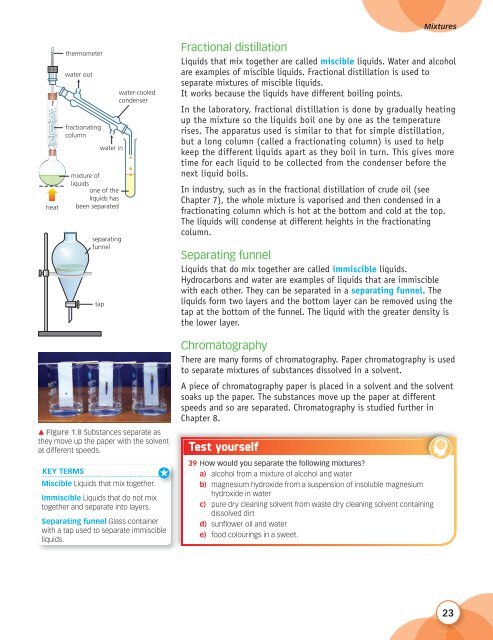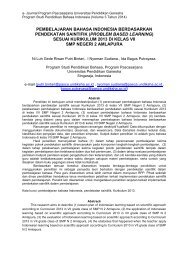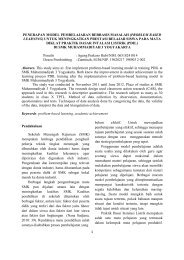Create successful ePaper yourself
Turn your PDF publications into a flip-book with our unique Google optimized e-Paper software.
heat<br />
thermometer<br />
water out<br />
fractionating<br />
column<br />
water in<br />
mixture of<br />
liquids<br />
one of the<br />
liquids has<br />
been separated<br />
separating<br />
funnel<br />
tap<br />
water-cooled<br />
condenser<br />
Mixtures<br />
Fractional distillation<br />
Liquids that mix together are called miscible liquids. Water and alcohol<br />
are examples of miscible liquids. Fractional distillation is used to<br />
separate mixtures of miscible liquids.<br />
It works because the liquids have different boiling points.<br />
In the laboratory, fractional distillation is done by gradually heating<br />
up the mixture so the liquids boil one by one as the temperature<br />
rises. The apparatus used is similar to that for simple distillation,<br />
but a long column (called a fractionating column) is used to help<br />
keep the different liquids apart as they boil in turn. This gives more<br />
time for each liquid to be collected from the condenser before the<br />
next liquid boils.<br />
In industry, such as in the fractional distillation of crude oil (see<br />
Chapter 7), the whole mixture is vaporised and then condensed in a<br />
fractionating column which is hot at the bottom and cold at the top.<br />
The liquids will condense at different heights in the fractionating<br />
column.<br />
Separating funnel<br />
Liquids that do mix together are called immiscible liquids.<br />
Hydrocarbons and water are examples of liquids that are immiscible<br />
with each other. They can be separated in a separating funnel. The<br />
liquids form two layers and the bottom layer can be removed using the<br />
tap at the bottom of the funnel. The liquid with the greater density is<br />
the lower layer.<br />
▲ Figure 1.8 Substances separate as<br />
they move up the paper with the solvent<br />
at different speeds.<br />
KEY TERMS<br />
Miscible Liquids that mix together.<br />
Immiscible Liquids that do not mix<br />
together and separate into layers.<br />
Separating funnel Glass container<br />
with a tap used to separate immiscible<br />
liquids.<br />
Chromatography<br />
There are many forms of chromatography. Paper chromatography is used<br />
to separate mixtures of substances dissolved in a solvent.<br />
A piece of chromatography paper is placed in a solvent and the solvent<br />
soaks up the paper. The substances move up the paper at different<br />
speeds and so are separated. Chromatography is studied further in<br />
Chapter 8.<br />
Test yourself<br />
39 How would you separate the following mixtures?<br />
a) alcohol from a mixture of alcohol and water<br />
b) magnesium hydroxide from a suspension of insoluble magnesium<br />
hydroxide in water<br />
c) pure dry cleaning solvent from waste dry cleaning solvent containing<br />
dissolved dirt<br />
d) sunflower oil and water<br />
e) food colourings in a sweet.<br />
23





